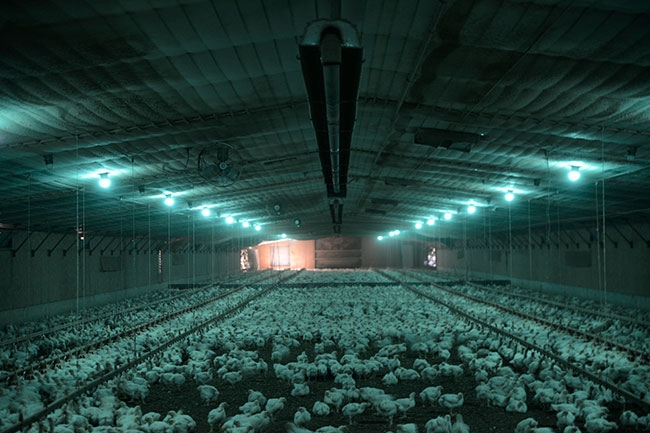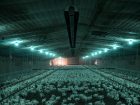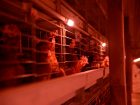
Poultry lighting trends
By Melanie Epp
Features Equipment New Technology Production Lighting Poultry ProductionNew insights into the role of LEDs.
 Research on both pullets and broilers has shown that blue and green LED lights enhance growth. PHOTO CREDIT: Once Inc.
Research on both pullets and broilers has shown that blue and green LED lights enhance growth. PHOTO CREDIT: Once Inc.In caged housing, laying hens respond well to artificial lighting. But as producers transition from traditional cages to aviaries, enriched colonies and free-range systems, questions about lighting will surface.
Why is lighting important for poultry? And how do you choose the right lighting for each system? Two poultry specialists, Dr. Ian Rubinoff, European account manager and technical services veterinarian at Hy-Line International, and Karen Schwean-Lardner, professor at the University of Saskatchewan in the department of animal and poultry science, share their expertise.
Lighting primer
In understanding the role of lighting in poultry production, it’s important to first know a bit about their biological makeup. In humans, light reaches the brain through the eyes. In chickens, light penetrates not only through the eyes, but also through the top of the skull in the pineal gland and through the pituitary gland in the hypothalamus. While we have just three cones (red, blue and green), chickens have four: red, blue and green, as well as a cone for ultraviolet light.
There are several different components to light. The first component is wavelength, which gives us colour. Chickens have the ability to see different wavelengths, and each one of those wavelengths has the ability to penetrate slightly different from the others.
Schwean-Lardner says that some of the research that’s just come out in the last few years is really looking to take advantage of how light penetrates into the brain.
The second component has to do with intensity – how light and how bright light appears. Light intensity impacts birds in a variety of ways. Darkness, for example, can be used to control aggressive behaviour.
Day-night cycle
The third component of light is day length – how many hours of light and dark there are in a given lighting program for birds. This is Schwean-Lardner’s area of expertise.
“Years ago, it was not uncommon for producers to have 23 hours of light in the barn, and some of the reasons were good reasons,” she says. “They thought if birds can see in their environment, they can go where they want all day long. They can feed. They can drink. They can be involved in social behaviours. But the research we did here a couple of years ago shows that that’s not what happens.”
Like humans, poultry need a day-night cycle. When birds have a regular day-night schedule, they develop the proper diurnal rhythms, explains Schwean-Lardner. This is important for functions like melatonin production.
“It is a normal cycle that is so important for birds because it drives things like immune function and growth rate and reproductive hormones,” she says. “By giving that day and night cycle, you improve the health of the birds, you improve the immune status, you improve mobility and you improve alertness.
“Birds tend to be more active when they have a day-night cycle,” she continues. “They’ll actually grow better, which is really interesting and totally opposite of what was thought 10 years ago.”
LED lighting
Another area of research that is of interest to Schwean-Lardner is the impact of using LED lighting in broiler barns. Earlier this year, the University of Saskatchewan received a $45,000 grant from the fast food burger chain A&W to help study just that. The study will examine mobility, behavior and physiological welfare of poultry living under LED lighting. Part of the work will also look at the impact of using different coloured lights.
Dr. Ian Rubinoff, Hy-Line International, spoke at the International Egg Commission’s Global Leadership conference in Bruges, Belgium in mid-September, sharing general observations, as well as recent findings in LED lighting. Generally, he said, it’s best to use cooler lights for pullets. “There’s a fair amount of research out there that says more green and blue spectrum helps to stimulate body growth,” he said.
“The exciting thing we’ve found also on the practical side is what impact light intensity has for pullets and what type of bulbs we should be using, especially as more and more people start using infrared heat treatment,” he continued.
Research shows that access to feed and water during the early stages of life is critical to the growth and success of that pullet flock. “The more light you can have inside the cage the better,” Rubinoff said. “So we really like to have bulbs that have very broad stretch into the cage or we want to have bulbs that are inside the rearing cage.”
In flat deck or flooring systems, he said producers want to make sure that their bulbs reach all the way down to the floor at minimum 30 lux, although 50 lux is better. “We also like to use dimmable bulbs, especially for the pullet area,” he said. “This is really essential because after the initial period we really like to decrease the light intensity to help the pullets grow and help stimulate them to eat.”
Laying hens, he continued, need to have enough red spectrum light. “We really want to make sure that whatever bulbs we’re buying, we buy the warm bulbs or the ones that are less than 3000k,” he said. “This can range from lights that have enhanced red spectrum or ones that are white or yellow.”
For traditional stacked deck or belted houses, for both cages and colony, the goal is even light distribution at all levels, said Rubinoff. “One thing that always interested me is that in modern chicken houses we try really hard to make things consistent, regarding food, ventilation and water,” he said. “And then we put lights in every four metres where we see this huge change in light environment by cage or by colony, without any consideration for what impact it may have on the chicken.
“For anyone who’s considering putting in a new caged facility or colony facility, I would encourage trying to go for a consistent lighting profile where either you have a bulb that evenly lights all the levels or you have a linear light that gives no gaps in light intensity between the different areas,” he continued.
For those moving into aviary or free-range systems, lighting gets a little trickier. Rubinoff believes that using LED lighting in these types of systems will provide more consistency, especially for birds with access to the outdoors.
“In some internal research we have noticed that when you move birds from an LED environment into a florescent environment that there is a scare response in those birds because they really are frightened by the difference and change in that light environment,” Rubinoff said. “Consistency is key.”
Hy-Line has also conducted some cost benefit studies to investigate how long it takes to make a return on investment when switching to LED lighting. At an average cost of US $0.10 per kw of energy, when incandescent lights are replaced with a standard LED, the return on investment was less than a month, Rubinoff said.
“The fastest I found was in 17 days your savings in energy paid for the LED bulb when you were using one of the less expensive LED bulbs,” he explained. “This is something I would encourage you to look at.”
Print this page

